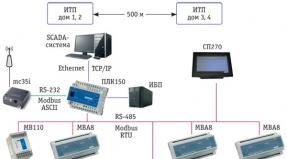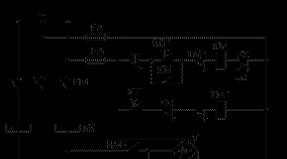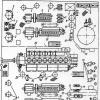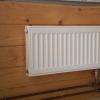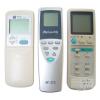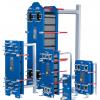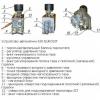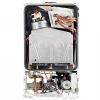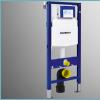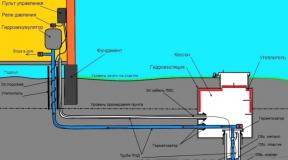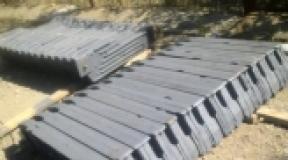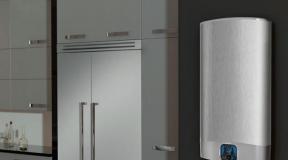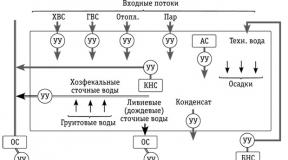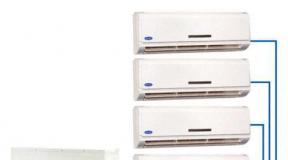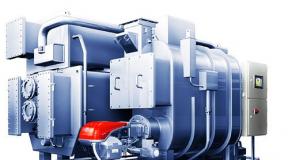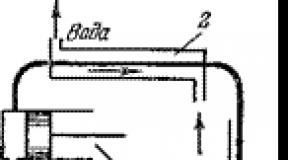Semi-industrial air conditioners: types, characteristics, features. Semi-industrial split systems and air conditioners Universal semi-industrial air conditioners description
Most models of semi-industrial air conditioners are characterized by significant power. They are able to work without interruption for many days, because their indoor units are more reliable than those that come with a household split system. The main task of industrial air conditioning systems is to precisely maintain climatic parameters at a given level required for a given technological process or storage conditions for inventory items.
The area of \u200b\u200buse of industrial air conditioners - production of various directions, trading platforms, catering establishments, public buildings, data centers, server rooms, etc.
Precision air conditioners
During their full service life, precision or cabinet air conditioning systems are 100% true to their name - they maintain the climate in the served room at the exact level of the parameters specified for them. The temperature in the room where the precision air conditioner is operating will correspond to the specified one with an accuracy of plus / minus 1 ° C, the humidity will be maintained at a given level with an accuracy of plus / minus 5%. Cabinet air conditioners are designed for non-stop operation for a full calendar year, subject to timely maintenance, their service life is over 10 years.
Externally, precision air conditioning devices look unattractive compared to household air conditioners - however, they do not need an exquisite design. This segment of HVAC equipment is highly specialized and is intended for technical premises in which a significant amount of technological equipment is installed - medical, hardware, telecommunications, etc. Precision air conditioners are also used to maintain a given climate in museum storages and warehouses. They are indispensable in conditions when storage facilities need a strictly defined climate or in a small area there is a significant amount of technological equipment, the successful operation of which is influenced by temperature and humidity drops.
In terms of their general design and principle of operation, precision air conditioners do not differ from other refrigeration devices. Depending on the model of cabinet air conditioning systems, the condenser is cooled by air or water. The air cooled by the device can enter the room in several ways, the most common is through the duct located at the floor or in the upper part of the air conditioner. If the room has a raised floor, then the cooled air is directed to the underground, and next to each device that needs cooling, an air-permeable grill is arranged in the raised floor. For technical rooms with a raised floor, special models of precision climatic devices are produced - they are placed directly in the underground, only air intakes go out. For floor-standing cabinet air conditioners, the preparation air is supplied through air intakes located at the top, side or behind the device.
Among the models of precision air conditioners, there are monoblock and double-block devices - the former outwardly resemble window monoblocks, only much larger, and the latter are similar to household splits with a simplified design. The complete factory set of cabinet air conditioners is designed for year-round use - the devices are equipped with electric heating elements and an air humidification system. The cooling capacity of precision climate control devices can be from seven to one hundred kilowatts, the weight of the indoor (indoor) unit is from 200 kg. The least powerful models (7 kW) cost about half a million rubles.
Multi-zone air conditioning systems (VRV and VRF)
Split systems, consisting of a common outdoor unit and several (from two to one hundred) indoor units, were developed in the 80s with the aim of expanding the range of household climatic devices. In the late 90s, the cost of air conditioners significantly decreased, which contributed to their massive distribution - more and more street split-blocks appeared on the facades of buildings, worsening the appearance of cities. Against this background, a number of mayors introduced restrictions on the number and location of street blocks of air conditioning systems on the walls of buildings, which made it impossible to install climate control devices in every room. And then multi-zone air conditioners took the first place, a powerful external split-block allowed connecting several indoor block-dryers to it - multi-zone split systems were allocated by manufacturers to a separate class of climate control devices.
In the line of multi-zone air conditioners there are household and semi-industrial models: the first are formed by an external unit and several internal ones (maximum four); the second - from several outdoor units, combined into a common section, and up to hundreds of indoor units. The range of cooling capacities of external units of household VRV and VRF air conditioning systems is 5-25 kW, the capacity of semi-industrial models is four times higher - 22-100 kW. The calculated power of the outdoor unit (units) of multi-zone air conditioners is actually higher than indicated in the device's passport - this is necessary to compensate for the total load created by the indoor units during operation. The outdoor split unit of the multi-zone air conditioning system is capable of withstanding 40% overload. The cooling capacity of indoor hair dryers is 2-18 kW. 
Room (indoor) blocks VRV and VRF of climate systems are no different from hair dryers of ordinary household split systems - they are controlled and configured by the remote control, and each indoor unit is connected to the external one independently of the others. Semi-industrial models of multi-zone split systems can be equipped with wall, ceiling, floor, cassette hair dryers, the total power of which does not exceed the power characteristics of an external split unit or a section of external units. The outdoor unit of the multi-zone air conditioner is connected to the indoor units via a two- or three-pipe line. The freon circuit of two copper pipes allows you to simultaneously either heat or cool all served rooms, and formed by three pipes, each indoor unit can operate in cooling or heating mode independently of the others.
Household models of multi-zone split systems with a 5 kW outdoor unit and two indoor units with five kilowatts of total cooling capacity cost about 170,000 rubles. Prices for semi-industrial multi-zone climate systems are determined by the complexity of building a freon line, the required power characteristics of the section of external blocks and the total number of internal hair dryers, the goals of building such systems.
Duct and roof air conditioning systems
Both types of these climate systems supply prepared air to the premises through the duct channels, otherwise their device is not the same and the most noticeable difference is two split-blocks for duct air conditioners and one for roof air conditioners.
Duct air conditioners... Their system includes an indoor unit called a fan coil unit and an external unit called a chiller. The fan coil unit is located in the most remote and noise-insulated part of the building (usually in the basement), as far as possible from the workplaces of the personnel - when the device is turned on, it emits a loud hum. The freon line that connects the fan coil and chiller into the air conditioning system does not exceed a maximum length of 50 m. The air outside the building is pumped through the duct into the fan coil, is purified and temperature-conditioned, and then sent to consumers. The chiller, exhibited outside at a certain distance from the building, depending on the operating mode of the system, serves to remove heat or cold from the fan coil. Equipped with thin air filters, duct air conditioners are able to perform multi-stage air purification, up to the elimination of dirt particles of one micron.
The range of cooling power of ducted air conditioning systems is 5-140 kW, the maximum air consumption is 25,000 cubic meters per hour. In the line of channel air conditioners there are three types of models - low-pressure with a pressure in the system up to 50 Pa, medium-pressure, developing a maximum pressure of 150 Pa, as well as high-pressure systems with a maximum pressure of 300 Pa.
Rooftop air conditioners... The only unit of rooftop air conditioning systems is installed on the roof of the building using a special frame. Air is pumped into the device, cleaned and subjected to temperature treatment, then it is directed through branched air ducts to the points of consumption. Such equipment is capable of performing ventilation of a building - supplying dust-free air without heating or cooling it.
 The general design of the roof monoblock is practically indistinguishable from the device of household monoblock air conditioners, for example, window air conditioners. The difference is that these devices are much larger and more powerful, their control is carried out by a complex set of automation that carefully monitors each working operation in order to avoid overheating. During operation, the air conditioner gets very hot, it desperately needs unlimited air access from all sides.
The general design of the roof monoblock is practically indistinguishable from the device of household monoblock air conditioners, for example, window air conditioners. The difference is that these devices are much larger and more powerful, their control is carried out by a complex set of automation that carefully monitors each working operation in order to avoid overheating. During operation, the air conditioner gets very hot, it desperately needs unlimited air access from all sides.
The capacity range of rooftop air conditioners is 8-140 kW, air consumption is 1500-25000 cubic meters per hour. Compared to ducted air conditioning systems, rooftop air conditioners are more compact, and the presence of one unit and the complete absence of an external freon line seriously simplifies assembly work - the impressive dimensions of the ducted fan coil may require partial dismantling of the wall in order to bring it into the basement.
Both air conditioning systems are installed discreetly, without hanging their elements on the facade of the building, easily cope with the air supply of the entire building, and are capable of operating in the recirculation (ventilation) mode. Their disadvantages are significant noise of installations during operation, noise in air ducts caused by air movement.
A careful calculation of the installation site of the climate system, equipping the air ducts with sound absorbers will allow minimizing the noise.
Cassette air conditioners
The proliferation of a false ceiling - a suspended ceiling - prompted design engineers from leading manufacturers of climatic technology to create an indoor split unit that could be built into a suspended ceiling. The external block of the cassette air conditioner does not differ in structure from similar blocks of other split systems, and the indoor hairdryer is a cassette installed in the suspended ceiling using an independent fastening system, the front panel of which is displayed on one level with the plane of the false ceiling.
A cassette air conditioner is installed in rooms with a ceiling height of more than 2.5 m; to hide its body in the space behind the suspended ceiling, at least 250 mm of distance from the sheathing plates to the plane of the real ceiling is required. In addition to the height of the internal block of the cassette split system, it will be important to pay attention to the power characteristics of the pump that pumps out condensate from the tray of the device - there are models with a pump that raises moisture by 400 mm in height, and there are also more powerful ones that can pump liquid to a height of 800 mm. As a rule, cassette air conditioners are not controlled manually - they are located too high, therefore they are equipped with a remote control, infrared or wired. 
The cooling capacity of split cassette systems is directly related to the dimensions of the internal hair dryer, there are two of them - compact (euro size) with a wall of 600 mm and a power of up to 6 kW, a conventional one with a wall of 800 mm and a power of up to 15 kW. Models with a capacity of 15 kilowatts are intended for premises with a total area of \u200b\u200b130-150 m 2.
The air from the room for subsequent cleaning and temperature preparation is pumped into itself by the cassette hair dryer through the air intake in the central part of the device. Air return is carried out from two or four sides of the front panel - this is another advantage of cassette air conditioning systems, which allows you to quickly create an atmosphere in the room with the required parameters.
The prices for cassette air conditioners are comparable to prices for other split systems with similar cooling capacity. For example, a 3.5 kW model costs about 17,000 rubles.
Ceiling air conditioners
The indoor hairdryer of the ceiling split systems is located under the ceiling and is attached to the ceiling plane, due to which the air jet from the device moves through the hottest layer of the room atmosphere, effectively cooling it. In addition, the flow of cooled air moving along the ceiling is guaranteed not to flow to the bodies of people in the room served by the ceiling air conditioner. Some models of ceiling split systems allow their installation both on the ceiling and on the wall - they are equipped with two drip trays (for horizontal and vertical installation of the device).
 The cooling power of the ceiling climate systems is 2.5-18 kW, respectively, the model's capacities are designed to maintain the required atmospheric parameters over an area of \u200b\u200b25-180 square meters. The maximum serviced area of \u200b\u200bceiling split systems is slightly higher than that of other semi-industrial air conditioners - due to the higher air flow rate they generate. Depending on the power characteristics, the width and length of the ceiling block-hair dryers can be different, but their thickness (height) is always in the range from 180 to 250 millimeters. The cost of the least powerful model - 2.5 kW - is about 30,000 rubles.
The cooling power of the ceiling climate systems is 2.5-18 kW, respectively, the model's capacities are designed to maintain the required atmospheric parameters over an area of \u200b\u200b25-180 square meters. The maximum serviced area of \u200b\u200bceiling split systems is slightly higher than that of other semi-industrial air conditioners - due to the higher air flow rate they generate. Depending on the power characteristics, the width and length of the ceiling block-hair dryers can be different, but their thickness (height) is always in the range from 180 to 250 millimeters. The cost of the least powerful model - 2.5 kW - is about 30,000 rubles.
Designed for air preparation in spacious rooms, ceiling air conditioners are installed in halls of large offices in which partitions do not extend to the ceiling, in industrial and commercial enterprises, restaurants and libraries.
At the end
In addition to the described types of air conditioning devices, semi-industrial air conditioners include column split systems, the cooling capacity of which reaches 50 kW and is sufficient to control the climate in rooms up to 300 m 2. But since this climatic technique has already been closely studied in, we will not return to its description.
Semi-industrial air conditioners are an extensive category of climate technology. This is a technique that is an intermediate link between household and industrial options. Due to their high power, the possibility of failure-free operation, as well as the special strength of the structure, these systems have gained popularity not only in industry, but also in everyday life.
In addition to small shops, shopping malls, cafes, restaurants, office and social premises, they can also be seen in multi-room apartments, cottages and country houses.
The main types of semi-industrial air conditioners
The variety of equipment on the market is so great that many get lost and cannot immediately decide which semi-industrial air conditioner to choose. We will try to remove this annoying misunderstanding.
The main representatives of the semi-industrial series are split systems, consisting of outdoor and indoor units. With sufficient power, they effectively cool and clean the air. The buyers are offered the following options:
- channel;
- cassette;
- columns;
- wall-mounted;
- ceiling.
Each of these systems has its own distinctive features that make it optimal choice for a particular object.
Channel semi-industrial systems
Modern climatic technology for suspended ceiling installation. Output power 12-25 kW. Wide functionality. For example, in the AUX brand, fresh air is added.
Due to the high power and installation features, it is possible to mount a functional and widespread system that will cool the air in several (4-5) rooms of an apartment, house or office at once.
Pros. Air conditioning for several rooms. Flush-mounted installation, fresh air mixing and a range of additional functions.
Minuses. It will not be possible to set different temperatures in all rooms without additional improvement (thermostat + electric valve for each indoor unit).
Too voluminous (long and ramified) communication system. Must be installed in a false ceiling. We'll have to redo the repair.
Cassette semi-industrial systems
A common type of semi-industrial air conditioner mounted inside false ceilings. Due to this, neither the airways, nor communications, nor the indoor unit itself are visualized. Only the air conditioner grill (60x60 cm or 120x60 cm) is visible on the ceiling, from where, in fact, air enters the room. In a number of models, such as in, the function of adding fresh air is realized.
Pros. Invisible. Functional. Capable of cooling large areas. The lattice plays a decorative role. Built-in blinds allow even distribution of air flows.
Minuses. Must be installed in a false ceiling. We'll have to redo the repair.
Column semi-industrial systems
A high-performance system that allows you to cool large rooms. It is installed in a specially designed area of \u200b\u200bthe room. A running air conditioner creates a strong flow of cold air. It is not only uncomfortable to be nearby, but also not recommended.
Pros. High cooling capacity. Ease of installation without damage to the interior. It is in demand in large shopping centers, industrial zones, where it is possible to install it and ensure optimal performance.
Minuses. It can only be installed where there are no special requests for design and there is free space. In size - like a refrigerator. It takes up part of the room and weighs a lot.
Wall mounted semi-industrial systems
The most common type of equipment, actively used in everyday life, as well as in offices, shops and other facilities, whose area does not exceed 70 square meters. meters. The indoor unit of the air conditioning system is mounted in close proximity to the wall on which the outdoor unit is located in order to shorten the length of air ducts and other communications. On average, their length is 5-7 m.
Pros. The most modest cost. Large selection of offers.
Minuses. Limited power - no more than 7 kW. Installation restrictions.
Floor-ceiling semi-industrial systems
A ceiling air conditioner can be a replacement for a cassette air conditioner if it is not possible to make repairs or mount a suspended ceiling. In terms of functionality, it is practically not inferior, and the pleasant design does not spoil the interior at all.
The installation principle of this technique is twofold:
- under the ceiling - with air flow along the ceiling;
- above the floor - with the air flow upward along the wall.
A number of premium models, such as c, have an Anti-Draft function. Built-in blinds allow you to direct the flow in 4 directions, adjusting its strength in each direction. Thanks to this, it is possible to zone the room, somewhere increasing the cooling, somewhere weakening.
Pros. High functionality, the ability to adjust the direction of the air. It can be installed without the obligatory installation of a false ceiling.
Minuses. It is not hidden. Don't choose budget options.
If necessary, you can also choose a multi-split equipped with different indoor units. Such a typesetting system allows you to solve any problems, which is very appealing to consumers.
Main characteristics of semi-industrial air conditioners
Power. This indicator in the semi-industrial series ranges from 5 to 30 kW, which is very good, given the compact dimensions and the quite acceptable cost of climate technology.
Scope of application. Air conditioners of this type are widely used in office premises, residential apartments, country cottages, country houses, sales areas of small shops and large shopping centers, production workshops, as well as any premises for social and public purposes. In a word, wherever the area of \u200b\u200bthe premises is 50-300 "squares".
Price bar. Considering that their power and functionality is much higher than that of household air conditioners, the price of semi-industrial options ranges from $ 250-5000.
Taking into account the current demand in the market, the Chinese brand AUX has developed a whole line of efficient and functional semi-industrial climate systems capable of providing unsurpassed indoor comfort and coziness. The models presented on our website are outstanding representatives of their category.
You can study their features and distinctive features, consult our specialist. We will be happy to help you choose the most convenient, reliable and profitable air conditioner.
The range includes both the classic series of semi-industrial split-systems HEAVY Classic, and the inverter series HEAVY DC Inverter with internal cassette, duct, floor-ceiling-type blocks in the full power range from 12 kBTU * to 60 kBTU. Hisense engineers paid special attention to the development of additional solutions in the field of individual and group control.
This allows the use of this equipment at objects of various levels and for solving any problems: from cooling server rooms to creating a comfortable air conditioning system for an office building.
Wide range of work
Thanks to the use of modern control algorithms and high-quality components, HISENSE semi-industrial split systems of all types can work in heating mode in an extended range of outdoor temperatures.


High efficiency compressor
All HISENSE semi-industrial air conditioners use only highly efficient compressors (rotary type and SCROLL) specially designed for use in professional equipment.
Extended track length and vertical drop
The use of professional-grade compressors, an oil recovery system and an adaptive operation control system allowed to increase the length of the route and the height difference between the indoor and outdoor units. This gives a great deal of flexibility when installing HISENSE semi-industrial air conditioning systems.

Two-board control and monitoring system with duplication of functions
More reliable control: With Dual PCB Control, the control system reads all performance data without any delay.
This allows for optimal control, intelligent defrosting, and protection against breakdowns. The split control system is protected against damage or the danger of improper power connections.

Additional management system features
Connect an access control card
This feature makes it very convenient to use HISENSE semi-industrial systems in rooms where it is necessary to automatically turn off the air conditioning system when there are no people in the room. For example, apartments or hotel rooms.

Fire Connection
The control system for semi-industrial systems allows you to connect smoke detectors to them, or other devices or control systems that signal a fire. When this contact is activated, the air conditioning system will be immediately turned off.


Safe work
HISENSE semi-industrial air conditioning systems are equipped with several levels of protection. One of them is the control of high and low pressure refrigerant. By controlling these parameters, the control system can stop the air conditioner in the event of an abnormal mode of operation, without allowing an accident.
Smooth soft start *

When starting the compressor and air conditioning motors, a large inrush current occurs. This problem especially arises when using air conditioners of high power.
HISENSE semi-industrial air conditioners have a special “SOFT Start” function that significantly reduces the starting load.
* For inverter systems
Or send a quick request
Split systems
Split system (from the English “Split” - separate) is an air conditioner consisting of external (compressor and condenser) and internal (evaporative) units. The external unit is usually mounted on the facade of buildings, the internal - indoors. The blocks are interconnected by two thin copper tubes in thermal insulation, which are held inside the walls, in suspended ceilings, behind wall panels or are closed with decorative plastic boxes.
Split systems eliminated two main drawbacks of window air conditioners: binding to a window opening and noise. The indoor unit of the split system can be installed anywhere, and not only on the wall: the indoor units, in addition to wall ones, can be floor, ceiling, pillared and built-in into the suspended ceiling - channel or cassette.
The noisiest part of the air conditioner is the compressor. In split systems, it is placed on the outer wall of the building, which allowed achieving ultra-quiet operation: the noise level of the most “advanced” models is only 22-26 dB.
Depending on the area of \u200b\u200bwhich space is required to be conditioned, as well as on the wishes of the customer, it is possible to install a split system of the selected types.
Wall-mounted split systems (for rooms of 10-100 m²)
Wall-mounted split systems are the most widespread in the Russian market; they are installed in apartments, country houses, offices, mini-shops, etc.
Such a wall-mounted air conditioner consists of an outdoor unit in which a compressor, a valve, a heat exchanger-condenser and a capillary tube are located, and an indoor unit in which a heat exchanger-condenser and electronic control are installed.
These split systems are designed for air conditioning in one room; Based on its area and ceiling height, the power of the installed unit is determined. As a rule, wall split systems have a number of useful functions - a timer, automatic curtains, the “I Feel” function; they are controlled by remote control.
Pros of wall split systems:
- noiselessness
- ergonomic design
- full feature set
- the ability to install almost anywhere in the room
Cons of wall split systems:
- need for professional installation
- relatively high price
- lack of fresh air
Multi split systems
 For conditioning, for example, an apartment with two or more rooms, you can use a multi split system in which up to four indoor units can be placed on one external unit. You just need to choose the right power of each indoor unit. The complexity of installation at the same time increases slightly.
For conditioning, for example, an apartment with two or more rooms, you can use a multi split system in which up to four indoor units can be placed on one external unit. You just need to choose the right power of each indoor unit. The complexity of installation at the same time increases slightly.
The use of multi split systems is also advisable if the weight of external units is limited.
Pros of multi split systems:
- economical solution
- the ability to use indoor units of different capacities
- one external unit
Cons of multi split systems:
- installation complexity
- higher price
- the impossibility of simultaneous work on heat and cold of different indoor units
- less reliability (one compressor and one control unit for several indoor units)
Channel split systems (for rooms 50-300 m²)
 Ducted air conditioners are designed to condition several rooms at once. Channel air conditioning, primarily designed for operation in recirculation mode, and as such it is closer to split systems. The main difference is that the indoor units of ducted air conditioners are installed behind a suspended ceiling, in walk-in closets, etc., and the air is taken in and out by air ducts in the air-conditioned rooms.
Ducted air conditioners are designed to condition several rooms at once. Channel air conditioning, primarily designed for operation in recirculation mode, and as such it is closer to split systems. The main difference is that the indoor units of ducted air conditioners are installed behind a suspended ceiling, in walk-in closets, etc., and the air is taken in and out by air ducts in the air-conditioned rooms.
The indoor unit of the channel air conditioner has a simpler design, since unlike split systems, it does not have design requirements.
Air is taken from the premises through the intake grille, the indoor unit passes and the duct system again flows into the premises through the distribution grilles. The unit has a more powerful fan, which allows overcoming the resistance of distribution ducts and grilles.
The channel air conditioner, as well as the split system, consists of two units - a compressor-condenser (outdoor unit) and an evaporative (indoor unit). The channel air conditioner is designed mainly for recycling only and may not always supply fresh air to the room. This is due to the fact that the temperature of the air supplied to the working area, according to the requirements of SNiP, should not be lower than 14-16 ° C. Therefore, at lower outdoor temperatures, it is necessary to heat the air taken from the street, even when the system is in cooling mode. Heated fresh air in the cool season can be provided by using models of air conditioners with a heat pump. However, in the cold season, when the outdoor temperature is below minus 10-15 ° C, the heating capacity of the air conditioner becomes insufficient.
To ensure a year-round supply of fresh air, in addition to a ducted air conditioner, it is necessary to install special electric or water heaters that provide the necessary heating of the supplied air in the cool season, or use separate supply ventilation units with built-in heaters.
Additional electric heaters or air handling units must have their own automation system. Therefore, if it is necessary to use a ducted air conditioner with fresh air all year round, it is necessary to develop an individual heater control system or install an additional control unit for the air handling unit. In both cases, this leads to complication and appreciation of the project and additional inconvenience to the user who is forced to “work” with two remotes.
Unlike conventional split systems that do not supply fresh air to a room, a split system with fresh air ventilation is a highly efficient air conditioning and ventilation system. You maintain the desired temperature in your rooms and the flow of purified fresh air in accordance with sanitary standards. At the same time, the interior design is not violated, because all the equipment is mounted behind a suspended ceiling. Only graceful decorative grilles for air supply remain in the interior.
It is advisable to use channel split systems in large rooms separated by partitions: apartments with high ceilings, offices, etc.
Advantages of channel split systems:
- the possibility of fresh air
- flush mounting
- large service area
Cons of channel split systems:
- false ceilings or decorative boxes required
- complexity of zone regulation
Cassette-type split systems (for rooms with an area of \u200b\u200b40-150 m²)
.jpg) Cassette split air conditioning systems are an ideal solution for air conditioning the whole building.
Cassette split air conditioning systems are an ideal solution for air conditioning the whole building.
Modern design, advanced technology for the production of plant components and raw materials provide cassettes with higher performance at one of the lowest noise characteristics. Cassette-type air conditioners of low power have a standard overall dimensions of the indoor unit 600 × 600 mm, and are designed for installation above a suspended ceiling, have a built-in control panel, which greatly simplifies installation of the product, and a controlled grille to ensure optimal comfort in controlling this system. Cassette type air conditioners are available in three sizes with a wide range of performance - from 3 to 15 kW, and can only work on cooling or in the heat pump mode. Cassette installations are usually designed with the use of a remote control or wall mounted climate control systems. Cassette models of air conditioners provide exceptional comfort and high efficiency.
Cassette air conditioners with air distribution in four adjustable directions of the cold flow are especially suitable for use in voluminous non-residential public premises, for example, in shops, offices, conference rooms, hospitals, schools and restaurants. In these models, air enters through an opening in the center of the unit, and chilled air is distributed in four directions. Maximum comfort is ensured when installing this cassette unit in the center of the room.
It is advisable to use cassette-type split systems in large hall rooms with false ceilings.
Advantages of cassette split systems:
- large area of \u200b\u200bservice;
- elegant design (only the front panel is visible);
- the possibility of an influx of fresh air;
- four-way air distribution.
Cons of cassette split systems:
- require false ceilings.
Floor and ceiling split systems (for rooms with an area of \u200b\u200b40-150 m²)
 In the case when the capacity of a conventional split system is not enough for high-quality conditioning of the room, and there is no possibility of installing a cassette type air conditioner (there is no suspended ceiling), or if the room has a very elongated shape, it is recommended to install floor-ceiling air conditioners, the power of which is usually 4 -15 kW in cold and heat.
In the case when the capacity of a conventional split system is not enough for high-quality conditioning of the room, and there is no possibility of installing a cassette type air conditioner (there is no suspended ceiling), or if the room has a very elongated shape, it is recommended to install floor-ceiling air conditioners, the power of which is usually 4 -15 kW in cold and heat.
The indoor unit of the floor-to-ceiling or floor-mounted air conditioner directs a powerful stream of chilled air along the wall or ceiling and thus ensures even distribution of temperature in the room.
Its original appearance is specifically designed for mounting on a ceiling or wall. The control panel can be remote or integrated into the indoor unit.
Split system of column type (for rooms with an area of \u200b\u200b80-180 m²)
Depending on the application, all air conditioners are usually divided into three groups:
- Household air conditioners (RAC - Room Air Conditions).
- (PAC - Packages Air Conditions).
- Industrial ventilation and air conditioning systems (Unitary).
Each group includes air conditioners of various types. Their features and applications are given in the table:
| Group | Household air conditioners | Semi-industrial air conditioners | Industrial systems |
| Types of air conditioners |
Monoblock: Split systems: |
Split systems: |
|
| Cooling power | from 1.5-2 to 7-8 kW | from 5-7 to 25-30 kW | from 5-10 to 200-5000 kW |
| Application area | Separate rooms in apartments, offices and cottages, as well as other residential and public buildings ranging from 10 to 100 sq.m. | Apartments, offices, cottages, trading floors and other premises for domestic, public and industrial purposes ranging from 50 to 300 sq.m. | Residential and administrative buildings, trading floors and sports complexes with an area of \u200b\u200bover 300 square meters. m., as well as industrial and specialized premises. |
| Distinctive features | Manufacturers of household air conditioners focus on developing an attractive design for the indoor unit of the air conditioner and reducing its noise level, as well as adding the maximum number of additional functions, the main one of which is air purification. The resource of air conditioners is 7-10 years, but many buyers change them earlier due to obsolescence of equipment and the appearance of models with new additional features. | Semi-industrial air conditioners occupy an intermediate position between domestic and industrial systems. They may have some additional functions to attract customers, while the resource and reliability of semi-industrial equipment is significantly higher than domestic. | The task of industrial systems is the uninterrupted performance of its main functions - cooling (heating) and ventilation. The most important parameters of such systems are the cost and complexity of operation, energy efficiency and the unit price of equipment (per 1 kW of cooling capacity). The resource of industrial systems is at least 20-30 years with year-round operation. |
| Price range | from 250-300 to 2000-5000 USD | from 1200-1500 to 10000-15000 USD | from 5000 USD and above |
Monoblock conditioners, split systems and multi-split systems
According to the design, air conditioners can be divided into the following classes.

